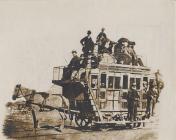The Mumbles Railway
Items in this story:
A world's first
On 25 March, 1807, a carriage full of people went was drawn by horse along Swansea Bay, from Brewery Bank alongside Swansea Canal, to Castle Hill in the village of Oystermouth, or Mumbles as it is more commonly known.
The line had originally been built in 1804 to transport limestone from the quarries of Mumbles to Swansea but, in 1807 the entrepreneur Benjamin French paid £20 to the Tramroad Company so that he could carry passengers along the line for a year. There was no road between Mumbles and Swansea at this time and the line prospered, despite the fare costing 2 shillings in 1813 which inevitably meant that only the well-off could afford to travel regularly. By 1823, the fare had been halved to a shilling and the line continued to prosper until a road was built in 1826. From then on, people tended to use the horse-drawn buses and the railway became less popular and went into administration.
'Hey-day' and decline
However, by the 1860s, the line was operational again and in August 1877 steam trains were introduced, with horse-drawn and steam trains running on the track at the same time until horses were phased out in the 1890s. In 1898 the new pier was opened in Mumbles and the railway was extended to the new tourist attraction. The pier’s popularity increased the railway’s traffic dramatically as Mumbles developed into a popular holiday resort. This was the ‘hey-day’ of the railway with up to 1800 passengers being carried at a time.
During the twentieth century, the railway suffered mixed fortunes. The Second World War saw the railway come into its own as fuel rationing increased reliance on other means of transport. After the war, the railway became less popular and administration problems led to its closure on 5 January 1960.

